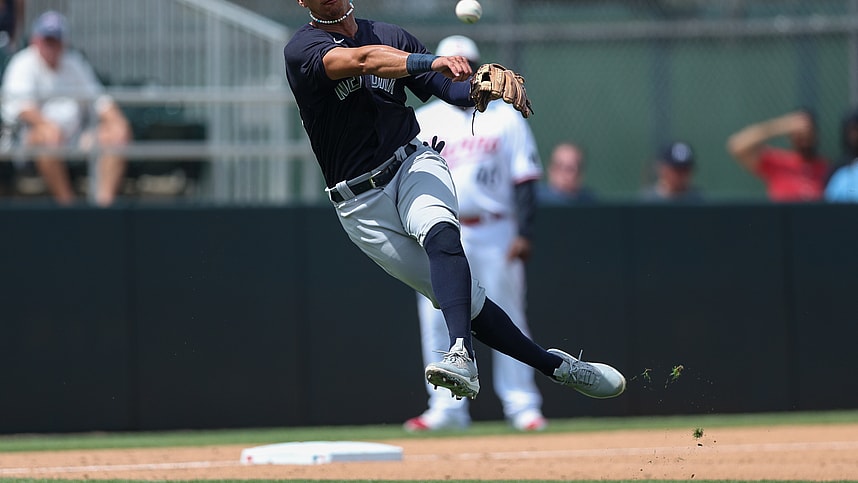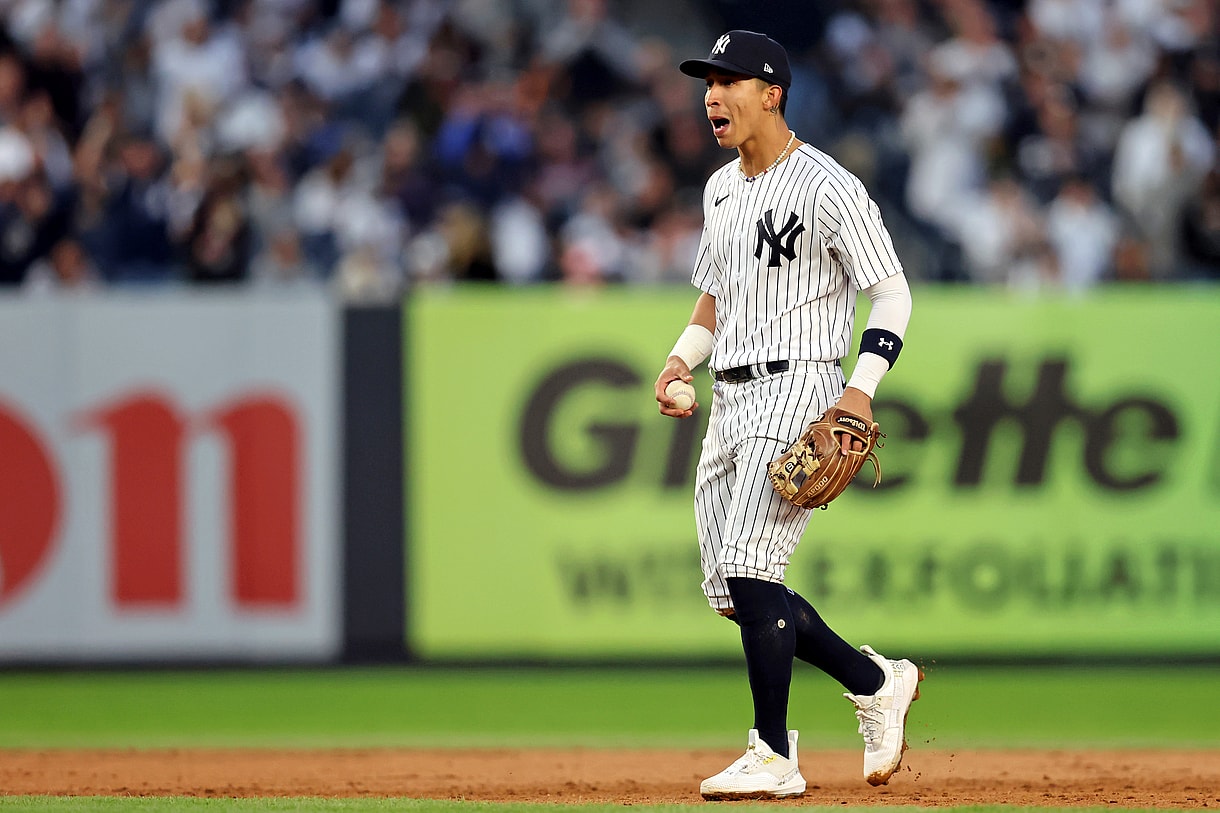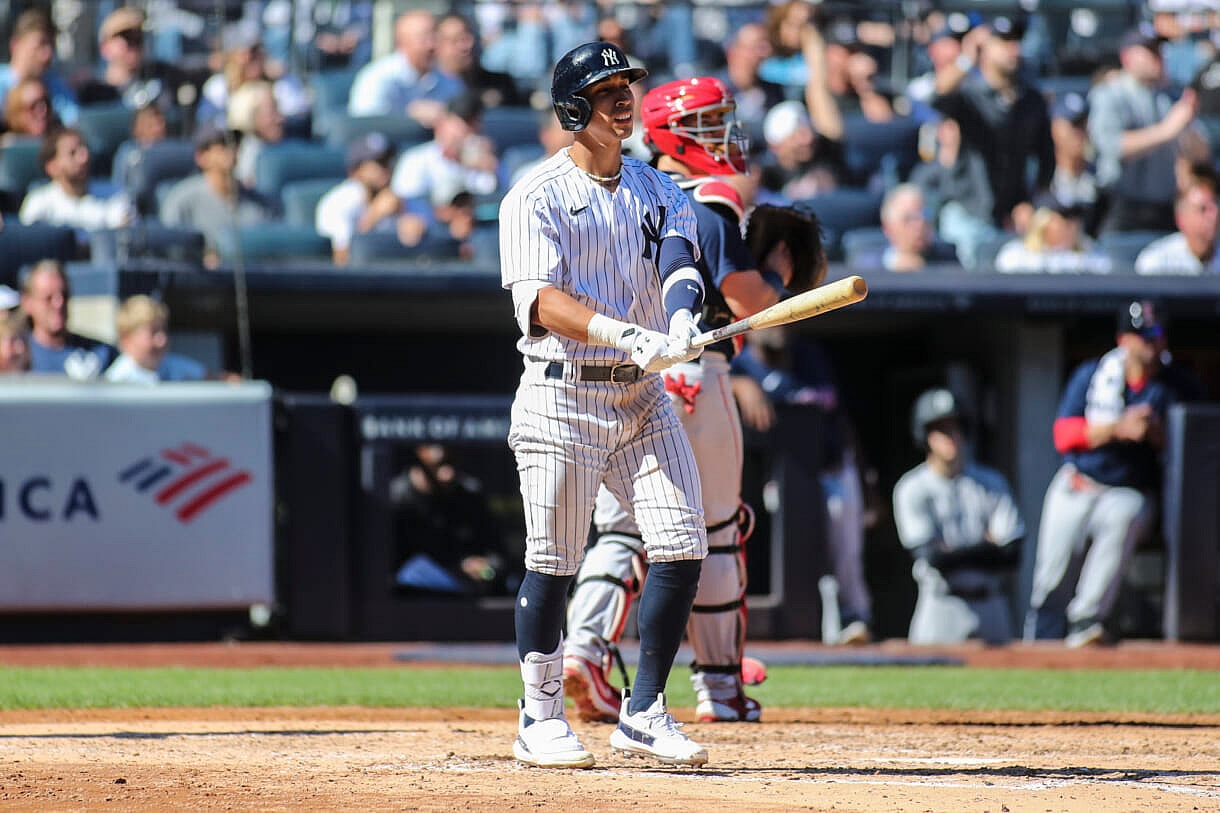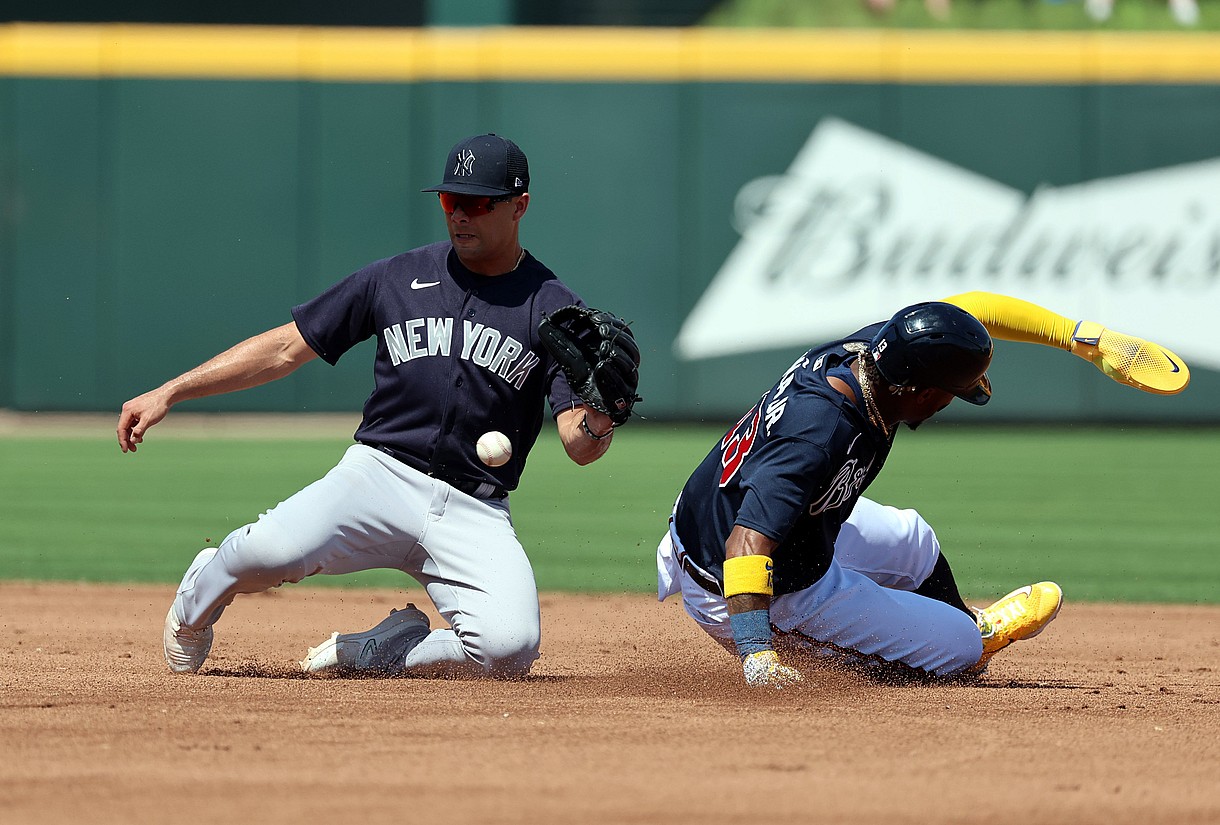
Oswaldo Cabrera in centerfield is on paper a pretty obscure idea, there’s just no way he could handle such a difficult position, right? Well, the Yankees are certainly putting Cabrera up to the task, but this shouldn’t just be a fun Spring Training experiment. When we look at the nitty-gritty with Cabrera’s outfield defense last year, we see that he has tools that can certainly translate well in centerfield, and while Harrison Bader is progressing well, it’s a skill Cabrera could keep utilizing when other injuries inevitably come up for the team. Versatility is invaluable, and for the Yankees’ exciting utilityman, he could become a legitimate option for the Yankees out in center.
- Yankees News & Buzz: Aaron Boone discusses roster; why Yanks didn’t make an offer to Luke Weaver, more
- How acquiring Freddy Peralta turns the Yankees’ rotation into a World Series juggernaut
- Yankees manager says team still has unfinished business in the offseason
Oswaldo Cabrera’s Defense Is Still Underrated
According to Statcast’s Outs Above Average, Oswaldo Cabrera was an average defender out in RF/LF, posting 0 OAA in 70 attempts, though the per rate version of OAA (Success Rate Added) has him as an above-average defender in RF with a 1% Success Rate Added. What people often overlook with OAA is that it doesn’t factor in your throwing value as an outfielder, making it an elite range metric but still an incomplete one. This is where DRS comes into play, as while the metric is disliked by Yankee fans for its elite grading of Isiah Kiner-Falefa in spite of his errors, it’s extremely valuable to pay attention to for outfielders.
Cabrera boasted an almost unthinkable 9 DRS in just 208.2 innings in RF, and while he posted 0 in LF, it’s important to note that he had just 70 innings out there, and DRS is a volume-based metric. Cabrera’s throwing velocity and decisions are elite, averaging 92.1 MPH on his throws despite having a serious shoulder injury that nearly required him to get season-ending shoulder surgery back in May. The Yankees were fortunate enough that his shoulder healed in time, but he aired it out when he played in the outfield for the Yankees frequently. Arm strength is a skill that tends to remain stable year-to-year in your physical prime, assuming health, but that’s not all.

Based on what I’ve described with Cabrera’s defense, it seems that he’s all arm and no range, but the numbers disagree here. With a more detailed look at Cabrera’s defense, we see that he covers three more feet on average versus the average outfielder, has above-average bursts, and also has above-average reaction times as well. He is slightly below average in his routes, but that’s a skill you can develop with more outfield work. His 55th Percentile Sprint Speed isn’t blistering, but it’s certainly enough with his natural physical tools to get to balls in the spacious centerfield.
Another encouraging sign here was that he handled left field decently well, and while the Yankees could keep Cabrera in LF and Judge in CF, is that something you want to do with a long-term investment like Judge? This isn’t to say Cabrera isn’t important enough to keep healthy, but rather that Cabrera could handle the position and help limit Judge’s workload in the regular season. The tools for Cabrera that are considered “sticky” (meaning there’s not a lot of change on a year-to-year basis) are above-average or elite, and I imagine Cabrera’s worked on his routes in Spring Training and in the offseason.
Oswaldo Cabrera isn’t just a serviceable defender in the outfield, he’s someone who would have had a legitimate stake at an outfield gold glove had he played a full season. This isn’t to say that Cabrera would be an elite defender out in centerfield, but what’s stopping him from being a solid defender out there?
An intangible factor here is the in-game motor and adaptability of Cabrera’s game, adjusting on the fly and playing a high-intensity game that’s made him a fan favorite. Oswaldo Cabrera as a centerfielder seems outlandish, but it wasn’t too long ago that he was a 2B/SS that the Yankees were now asking to play the corner outfield. His very first reps at any professional level at 1B came against the Milwaukee Brewers in 2022, and he clearly left a solid impression since the Yankees used him at 1B in Spring Training as well this year. He’s clearly got incredible defensive instincts and intuition, and when the physical and mental tools come together, you end up with an other-worldly defender.
Defensive tools and talent are a huge factor when we try to project defensive value, and it’s hard to argue that Oswaldo Cabrera doesn’t possess the requisite skills needed to excel in centerfield. Defensive data is fickle and can be a real head-scratcher, but the Yankees are on the right track with utilizing Cabrera’s tools in centerfield. With that being said, it’s not just the defensive factor with Cabrera, it’s also the bat he adds to the lineup and how important it is to get him in there daily with the Yankees’ question marks in the lineup.
That being said, anyone who’s read my content will know my fondness for projections, and they’re pretty low on Cabrera. Is this an indicator that his 2022 wasn’t sustainable, or are projections are missing something? In a weird way, it’s a mix of both.
Improving the Yankees’ Lineup
Projections really don’t like Oswaldo Cabrera’s bat, and this is a rare occasion where I vehemently disagree with how projections view a player. Cabrera’s always been a guy with a BABIP north of .300, and yet every projection system regresses his BABIP by about 20 points or more. I recognize the possibility that Cabrera could suddenly struggle with whiffs or chases again, but that seems to have been an aberration from just pressing in his first MLB at-bats. His AAA strikeout rate was 25.2%, but it was heavily inflated by the beginning of 2022 when he battled shoulder issues.
The issues on the surface are super obvious; on the season, he whiffed more than league average, chased more than league-average, and didn’t hit the ball particularly hard. In the three main indicators of offensive success, Cabrera was subpar. The AAA numbers weren’t overly impressive as well, with a 117 wRC+ and 26.4% K% not really blowing anyone away. The thing is, when we look under the hood and take the aforementioned shoulder injury into account, we see that we’ve got some misleading data. With a .287 xwOBA and .322 wOBA, Cabrera is, on paper, just an overperformer who got lucky, but there’s a huge flaw in that thought process.
His contact rates are strong enough for him to run a sub-25% strikeout rate, and he’s also been able to walk a decent amount at both AAA and the Major League level. Cabrera had a 10.3% career BB% with the Scranton RailRiders, and with the Yankees, he walked 8.8% of the time. The chase rates improved in-season for Cabrera as he stayed within himself and improved his swing decisions, and his walk rate is another area projections take the under on while I take the over. Cabrera doesn’t possess any elite physical tools at the plate, with league-average raw power and just solid contact rates and swing decisions, but he also doesn’t have a massive flaw either.

Could Cabrera find more consistency with his quality of contact? Absolutely, but it’s not something that’ll hinder him much since it’s harder to generate hard contact in the air than on the ground. You can hit a ball 93 MPH in the air for a home run, you can’t necessarily get that same level of damage on a groundball hit at the same velocity. This transitions us to the one thing Cabrera absolutely excels in, and that’s his pulled flyball rates. If you’ve ever read my work prior to this article, you know I’m infatuated with pulled flyballs, and that’s because they’re the best way to optimize your flyballs and barrels and convert them into damage.
The common expression is “chicks dig the long ball,” but I think every fan should dig the long ball. Cabrera may not hit .300, he may not be a leadoff candidate, run the lowest K% in the game, or lead any exit velocity leaderboards, but he can definitely put the ball in the seats. His offensive approach seems to mirror his defense in the sense that he just does a lot of things at an acceptable level, and his one elite tool glues everything together. Did I also mention that this super utility man is also a switch-hitter? It gives the Yankees a potential left-handed bat with pop to break up righties in the middle of the lineup.
Spring Training can be a pretty poor indicator of future results due to worsened competition and small sample sizes, but Cabrera’s averaging nearly 90 MPH on his exit velocities, and he’s maintained his improvements in swing decisions.
- 56.7% Swing%
- 22.1% Whiff%
- 21.7% Chase%
Cabrera is staying aggressive with his swings without expanding the strike zone or swinging and missing, and while Spring Training certainly presents easier competition, the process for his success early on is excellent. Swing decisions are something that I emphasize heavily since swinging at pitches in-zone creates better batted-ball outcomes. Strikes are easier to hit than balls are most of the time, and laying off of pitches out of the zone can force a pitcher to miss in-zone as well.
The Yankees having Cabrera’s bat frequently in the lineup will only benefit them since it allows fewer plate appearances for guys who are potentially struggling in the lineup and also makes the Yankees less right-handed. He’s electric, he’s dynamic, he’s Oswaldo Cabrera, and he has to be in this lineup as much as humanly possible.
Continuing the New Trend of Versatility
You may not like Isiah Kiner-Falefa playing the outfield, but the Yankees adding versatility can only help them. End of the day, injuries are a constant in baseball, and you’re going to have to play guys at their secondary positions or even play bench guys to stabilize your lineup, and Cabrera is a huge part of that for the Yankees. They don’t have an elite position player group, but they have a good one with plenty of MLB-caliber talent. Josh Donaldson, Aaron Hicks, and Isiah Kiner-Falefa are players that people don’t want to see in the lineup (and understandably so), but they’re still MLB-caliber players for all intents and purposes.
They all provided roughly league-average WAR value in 2022, and that’s something the Yankees can certainly use off of the bench in a pickle. Marwin Gonzalez, Estevan Florial, and Miguel Andujar were the primary depth for the Yankees when injuries arose, and outside of Gonzalez’s versatility, they provided nothing of substance to the team. Donaldson is at least an elite defender and league-average hitter, Hicks posted great defensive numbers in LF and can run, and IKF is a gold-glove defender at 3B with good contact and speed tools.

What separates Oswaldo Cabrera from those three is that he’s a really good player that also bails the Yankees out of injury situations. Harrison Bader’s injury (while minor) still stings, but Cabrera probably improves the lineup over Bader due to his switch-hitting, meaning the team as a whole doesn’t take much of a step back. DJ LeMahieu, Giancarlo Stanton, and Anthony Rizzo all spent time on the IL in 2022, and Cabrera gives them the option to just plug in a quality bat and glove wherever he’s needed.
Continuing to develop Cabrera in centerfield only opens up creative and intuitive lineup ideas in the regular season and postseason, and it also keeps them covered in case of any injury. Besides the catching depth and pitching depth, Cabrera adds to every single position on the baseball diamond. There is a legitimate argument to be made that the direct backup to eight of the nine projected starters when healthy is Oswaldo Cabrera, and the tools are certainly there for him to continue to make that the case.
The Yankees have to also protect Aaron Judge as he enters the first year of a nine-year deal, and that includes getting Cabrera in the outfield and Judge in RF/DH more often. Whether it’s his jumps, reactions, range, or his arm, Oswaldo Cabrera has what it takes to man centerfield while Bader’s out and even as an emergency option in case of another injury to the Bronx native. Baseball is evolving into a game of versatility and athleticism, and Ozzie embodies all of those qualities. He’s the utilityman every team dreams of having, and for the first time in a while, the Yankees have great position player depth entering the season.
More about: New York Yankees